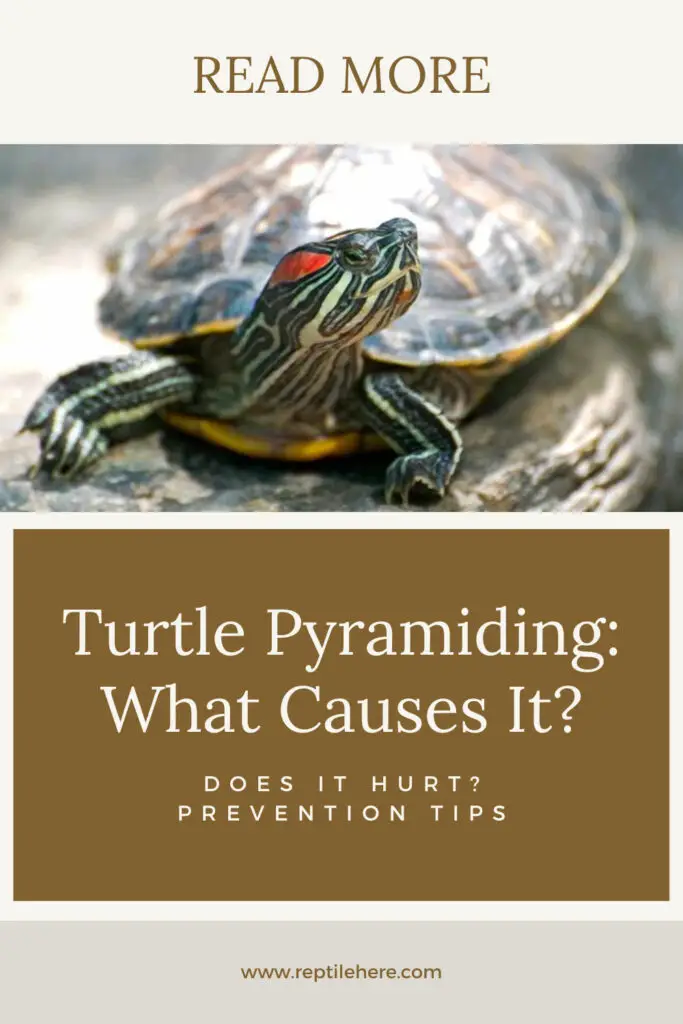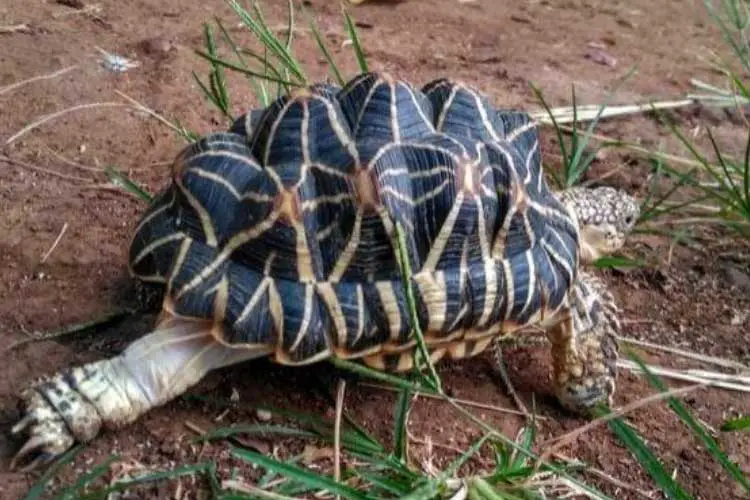Turtle Pyramiding: What Causes It? Does It Hurt? Prevention Tips
If you suspect your pet turtle has shell pyramiding but are not sure about it, you’ve come to the right place. Turtle shell pyramiding is a shell condition that makes your turtle shell scutes look pointy—hence the term pyramiding.
Turtle pyramiding is a shell deformity that is usually attributed to not taking good care of your little friend and it affects pretty much any species of turtle. It may be quite challenging to fix, especially when detected in the late stages, and may also bring about other health issues in your turtles.
This guide provides you with all the information you need to know about shell pyramiding. You’ll discover all the key causes, early signs to watch out for, and how to fix it and prevent it from catching up with your turtle. Plus, you’ll learn whether shell pyramiding is reversible or not.
Why is my turtle pyramiding?
Contents
Turtle shell pyramiding refers to an abnormal upwards growth of turtle scutes. The result of this growth is that each scute becomes bumpy or forms a pyramid-like shape—hence the term pyramiding.
It can be easily identified by the individual scutes of the turtle getting deformed.
Note that this turtle with pointy shell issue is more common in captive turtles compared to the wild ones. It’s also not considered to be dangerous unless it has developed into severe stages.
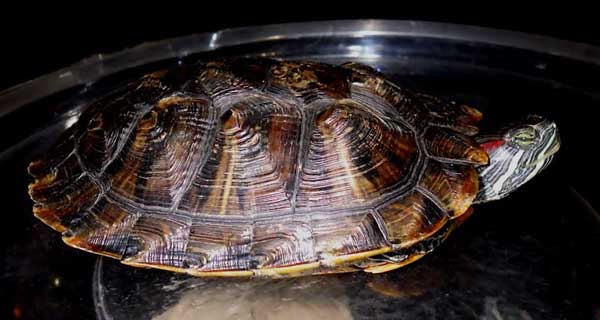
Moreover, it’s common in aquatic turtles, including the most popular pet turtles like the red-eared sliders. But it is more common in tortoises than in turtles.
What are the causes of pyramiding in turtles?
Now that you understand what turtle pyramiding is all about, let’s take a closer look at the factors that make your turtle shell start pyramiding.
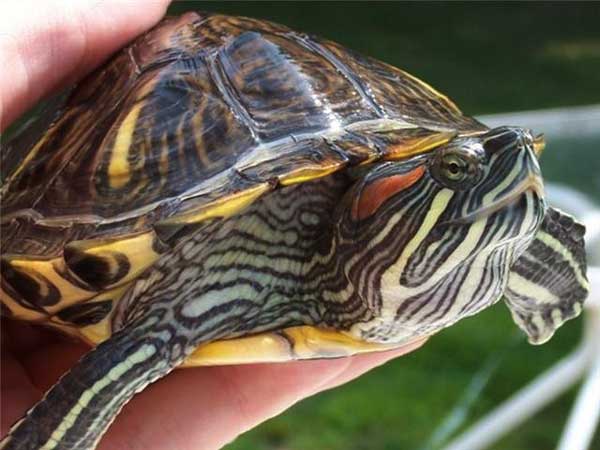
Poor diet
One of the primary causes of shell pyramiding in turtles is overfeeding proteins such as pellets, shrimps, etc.
If you overfeed your turtles too much protein or fat, then your turtle’s shell will start pyramiding. Also, a diet with a calcium-phosphorous imbalance can lead to this shell deformation.
That said, you should avoid giving your turtle too much one of type of food at a go. Instead, make sure you give them a balanced diet that comprises a wide range of veggies
Insufficient UVB lighting
An environmental-related reason why your turtle may suffer pyramiding is due to a lack of sunlight exposure.
As you may already know, your pet requires exposure to direct sunlight to absorb UVB rays. These rays are crucial for the synthesis of Vitamin D3 for proper absorption of the calcium you feed your turtle.
Calcium is a crucial mineral for proper bones and shell development. Lack of it can not only lead to metabolic bone disease (MBD) but also increases the risk of shell pyramiding.
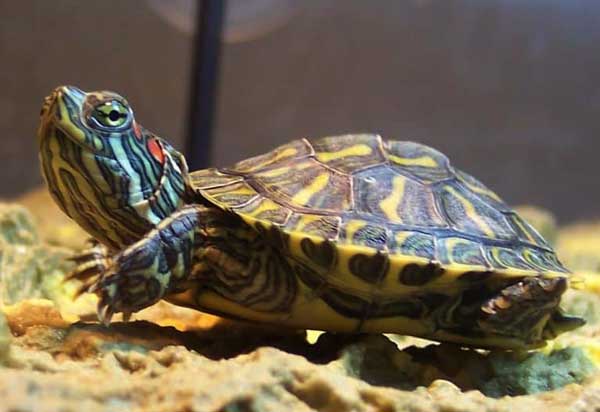
If you don’t expose your turtle to direct sunlight or even UVB lighting (for indoor tank setups), then its shell can get easily damaged.
Make sure your pet gets enough exposure to UVB lighting if it’s in an indoor setting. And if you have an outdoor setting for your turtle, it should be set up such that your little friend enjoys maximum sunlight exposure.
Low levels of humidity
Another environmental factor that makes your turtle’s shell pyramid is low humidity levels. Humidity plays a key role in the life and health of your turtle.
This issue is more likely to affect your box turtle pet or any turtle that you house outdoors, where maintaining optimal humidity levels is usually a hassle.

Moreover, this humidity problem becomes a problem if you reside in areas where the humidity levels fall below 60% most of the year and you’ve got your pet outdoors.
Make sure your turtle tank’s relative humidity is around 80% just above the substrate surface and close to your tank substrate (i.e., 98% below). This is especially true if you have box turtles as pets.
Lack of exercise
Lack of exercise translates to inactivity and is another reason your turtle may start showing signs of pyramiding.
This is the case for turtles housed in an indoor enclosure where they don’t get to move out and around more often.
Even worse, most turtle owners tend to house their pets in tanks that are too small such that the turtles can’t move around freely. This is wrong, given that turtles like swimming, a lot!
Be sure to provide your turtle with a large enough enclosure and introduce various accessories and decorations inside to entice your pet to move around and explore.
Early Signs of pyramiding in turtles
The most common sign of shell pyramiding in your pet is a turtle with bumps on shell. In other words, the shell gets deformed and the individual scutes assume pyramid shapes.
Generally, a healthy turtle should have its shell growing horizontally and feeling smooth (well, for most species).
However, if the turtle lacks good housing and a proper diet, its shell growth shifts from the expected horizontal to the abnormal vertical, creating a bumpy and unappealing shell.
You should look for rigid and bumpy shell scutes as the earliest symptoms when trying to identify/diagnose your turtle for pyramiding.
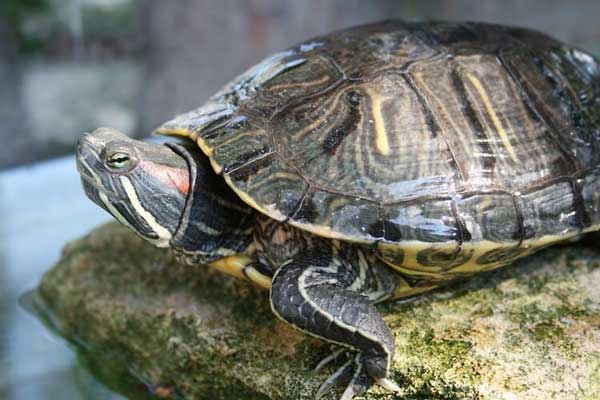
Note that this shell pyramiding condition can be minor or severe.
In severe cases, this shell condition can easily affect the animal’s normal lung functioning. It may also affect a female’s ability to lay eggs. Your turtle legs may also become weak and move unnaturally, causing an overgrowth of toenails and even arthritis!
Since pyramiding effects are also felt around the spinal cord, it can also cause paralysis in your pet. And in the worst-case scenario, it can cause death to your beloved pet at a young age.
When pyramiding is so severe, it will affect your turtle’s overall health and mobility.
Pyramiding shouldn’t be confused with scute retention. The latter is simply where the scutes fail to fall off during shedding. This makes part of your shell scutes appear quite brittle and look like they’ll break with the press of a finger.
Most people also tend to confuse shell rot or aging with shell pyramiding in your turtle.
Check the video below for helpful tips on how to differentiate between these different shell conditions.
How do you treat pyramiding in turtles?
As we discussed earlier, pyramiding isn’t good for your pet turtles, so you should act on it as soon as possible before it deteriorates your pet’s shell health.
But how do you treat it? The truth is, you can’t reverse pyramiding in turtles (more details coming up in our next section).
Treatment in this case means keeping things under control by correcting what may have caused the pyramiding. This could be an improper diet or poor environmental conditions such as low humidity, insufficient UVB exposure, and so on.
That said, one way to fix pyramiding in your pet turtle is to give them lettuce. To be more specific, give them romaine lettuce leaves to float in their tank.
However, once you address the possible cause behind the shell pyramiding in your turtle, the condition will not worsen.
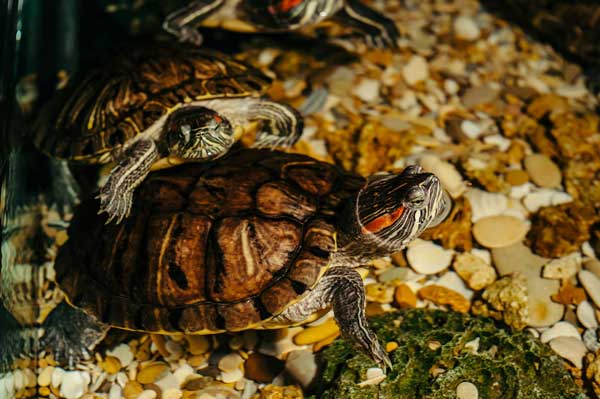
Your turtle will continue living a normal life as it does with healthy shell growth. But this will only hold true if the pyramiding wasn’t severe enough to interfere with its movement or breathing.
TIP: If your turtle is pyramiding, you may want to consult your vet for expert guidance on how to deal with it.
Also, if your pyramiding is severe and your pet is showing other complications and you suspect it’s tied to pyramiding, consult your vet immediately!
Can turtle pyramiding be reversed?
Unfortunately, shell pyramiding is one of those unhealthy turtle shells problems that are hard to fix. To be honest, you can’t easily reverse a shell pyramiding. The only thing you can do is keep pyramiding from getting worse.
Keep in mind that the pointy shell scutes you see are an exhibition of the shell and underlying bone structure of an animal that has been permanently carved in that specific manner, so reversing is pretty much impossible.
It is just the same way you can’t reverse a shell that has grown correctly.
However, if you detect this issue at a young age—when your baby turtle still got a lot of growing to do—you can easily keep this condition under control and correct it as your pet grows into an adult. Again, this is only possible if you detect it at the early stages.

Even in baby turtles, the condition is irreversible. But if you correct it as early as possible, then the signs will become less noticeable as he/she grows.
The early years are key to keeping this condition under control. You want to ensure you feed your turtle a balanced diet and accommodate it in a comfortable enclosure where all the conditions are optimal.
If you ever notice your turtle shell featuring raised scutes, this is most likely an early sign of a pyramiding shell. Quickly assess their environment as well as diet and see what needs to be changed, and adjust it accordingly.
And be sure to document the progress to see if the adjustments you made are bringing in any positive changes. Regularly taking pictures of your pet is a good way to keep tabs on the progress over the next few months.
How do you prevent shell pyramiding in turtles?
As we’ve just said above, reversing shell pyramiding in turtles isn’t easy once it settles, so why not take maximum precaution to ensure it doesn’t happen to your turtle in the first place?
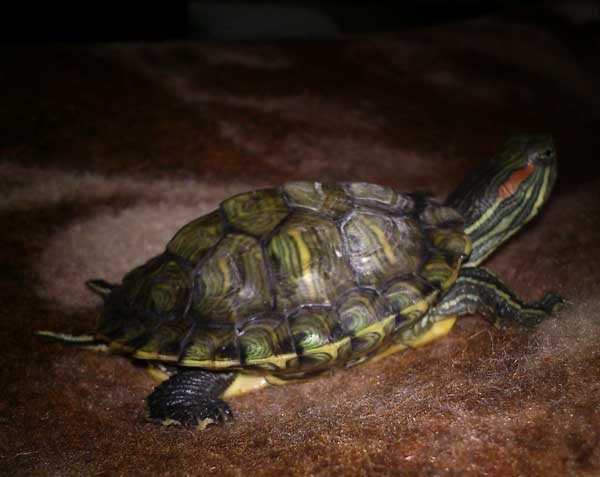
Below, we take a closer look at some helpful tips to keep away this shell disease from your little friend.
Feed your turtle a balanced diet
One of the ways to ensure your shell scutes don’t grow into hills is by feeding them a proper diet. You may want to hold back on foods containing proteins as it’s the main culprit behind pyramiding.
Give your turtle a balanced diet that comprises not only animal products but also vegetables and fruits. Adult turtles have less protein requirements than their young ones.
So, you should feed them a mixture of greens plus well-balanced commercial pellets. The greens, e.g. spinach, kale, collard greens, etc. will ensure your pet gets enough calcium while keeping protein consumption low.
If necessary, you can also supplement your turtle diet with vitamin D3 and calcium supplements to ensure they get the correct amounts of calcium.
Give your turtle maximum UV light exposure
If you have your turtle housed indoors, then you should provide them with a well-setup basking area, with a strong basking light for maximum UVB light absorption.
And keep in mind that these UVB lamps ought to be changed around every 6 months to ensure continued effectiveness in producing quality UV lighting for your pet.
Besides these rays, these lamps also provide heat which helps keep your turtle comfortable in its enclosure.
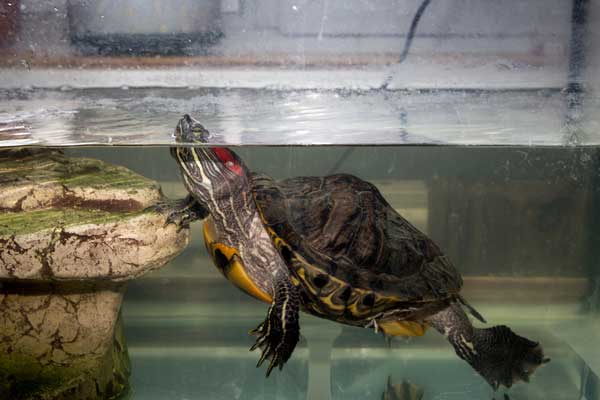
For turtles and tortoises that are housed outdoors, just make sure they get excellent exposure to natural sunlight. This is absolutely the best source of UVB light!
Maintain optimal humidity levels in your turtle tank
Keeping humidity levels in check is only relevant if you keep your turtle in an indoor enclosure. Aim for humidity of around 65 to 70%. Get a digital hygrometer to help you keep track of your turtle enclosure humidity.
Other tips to ensure proper humidity levels include introducing moisture-retaining substrate in the tank, investing in a humidifier, spray misting the enclosure, or getting a humid box for your turtle tank.
Promote physical activity
Introduce accessories and decorations in your turtle tank that encourage physical exercise. Moving and rearranging décor every now and then is also key to enriching your turtle’s tank.
You can also provide live food to awaken your turtle hunting instinct and make them move around. Taking your turtle off its enclosure once in a while to roam around is also a good way to make them exercise.
Above all, ensure the tank enclosure is big enough to enable your pet to swim freely.
Watch the following video for more details on how to enrich your turtle tank and promote exercise.
Does pyramiding hurt turtles?
Pyramiding in turtles isn’t painful and doesn’t seem to bring any suffering to these animals. They can be seen walking and eating comfortably despite their cells looking pointy.
However, this doesn’t mean that this shell problem is nothing to be worried about.
Pyramiding itself is a sign that your turtle is living in poor conditions. This could be anything from a poor diet to poor environmental conditions. If these poor conditions aren’t taken care of, they can lead to more serious health problems.
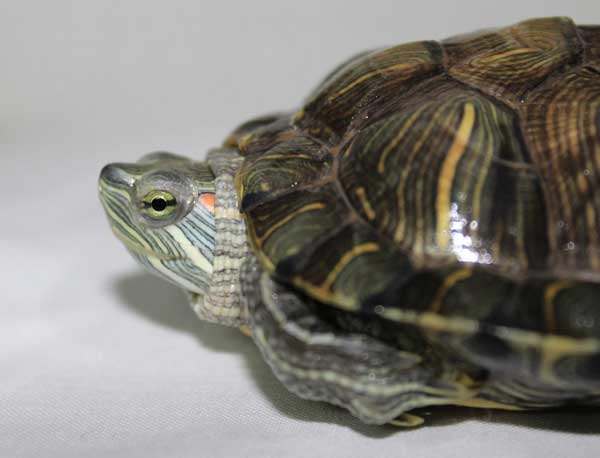
Pyramided turtles may also have problems walking if it’s in severe stages. The issue can also affect the spinal cord, which may ultimately even lead to paralysis.
This shell deformity may also affect your pet’s reproductive health. The males may also struggle to mate and the female may struggle to lay eggs.
Can baby turtle get shell pyramiding?
It is also possible for baby turtles to get shell pyramiding disease if they lack a balanced diet and are subjected to poor UVB lighting, and low humidity, and put in a small tank where they can’t freely move around.
As you already know, most baby turtle species are more inclined to a carnivorous diet. It’s not until they’re about 3-4 months of age that they shift towards an omnivorous as they age.

Thus, juvenile pellets generally have more proteins than adult pellets. and feeding your young turtles more pellets will increase their chances of getting the pyramiding problem.
You’d want to hold back on proteins. For instance, you may consider giving your turtles adult pellets since they contain less protein than baby turtle pellets.
FAQs:
Pyramided shell in red-eared slier is irreversible. However, you can fix it by adjusting your turtle’s diet and environmental conditions to keep the pyramiding from getting worse. As for a baby red eared slider, pyramiding is much easier to fix provided it’s detected early enough.
The most tell-tale sign that your turtle is pyramiding is excessive upward growth of its shell. The individual scutes look pointy and assume a pyramid shape.
Your turtle’s shell being bumpy is most likely due to the shell pyramiding problem. You may want to check if you’ve been feeding your pet a diet containing too much protein and fat and imbalanced vitamins and minerals. You should also check if your turtle gets enough ultraviolet light and adjust accordingly to keep the pyramiding under control.
Final Verdicts
Shell pyramiding is a condition that ends up deforming your turtle’s shell and can be hard to reverse. The most contributing factor to this issue is poor husbandry. Poor diet, lack of sufficient lighting exposure, and low humidity are the risk factors that will make your pet exhibit this abnormal shell growth.
Unfortunately, shell pyramiding is irreversible. But if detected early, it can be kept under control by adjusting your pet’s diet and environmental conditions. Prevention is key to ensuring your turtle shell doesn’t pyramid in the first place. Just ensure your turtle isn’t overfed, has a large tank with optimal conditions, is well exposed to UVB rays, and stays active.
